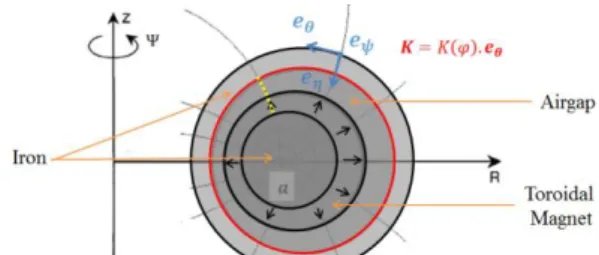HAL Id: hal-03113622
https://hal.archives-ouvertes.fr/hal-03113622
Submitted on 18 Jan 2021
HAL is a multi-disciplinary open access
archive for the deposit and dissemination of
sci-entific research documents, whether they are
pub-lished or not. The documents may come from
teaching and research institutions in France or
abroad, or from public or private research centers.
L’archive ouverte pluridisciplinaire HAL, est
destinée au dépôt et à la diffusion de documents
scientifiques de niveau recherche, publiés ou non,
émanant des établissements d’enseignement et de
recherche français ou étrangers, des laboratoires
publics ou privés.
3D Hybrid Model of an Ideal but True Toroidal Flux
Machine
Théo Carpi, Yvan Lefèvre, Jean-François Llibre
To cite this version:
Théo Carpi, Yvan Lefèvre, Jean-François Llibre. 3D Hybrid Model of an Ideal but True Toroidal Flux
Machine. CEFC 2020, Nov 2020, Pisa, Italy. pp.0. �hal-03113622�
OATAO is an open access repository that collects the work of Toulouse
researchers and makes it freely available over the web where possible
Any correspondence concerning this service should be sent
to the repository administrator:
tech-oatao@listes-diff.inp-toulouse.fr
This is an author’s version published in:
https://oatao.univ-toulouse.fr/2
7027
To cite this version:
Carpi, Théo and Lefèvre, Yvan and Llibre, Jean-François 3D Hybrid
Model of an Ideal but True Toroidal Flux Machine. (2020) In: CEFC 2020, 16
November 2020 - 18 November 2020 (Pisa, Italy). (Unpublished) .
1
3D Hybrid Model of an Ideal but True Toroidal Flux Machine
Theo Carpi, Yvan Lefevre, and Jean-François Llibre
Laboratoire Plasma et Conversion d’Energie (LAPLACE), University of Toulouse, CNRS, 31000 Toulouse, France
Abstract— This paper deals with a 3D hybrid model of a new concept of electrical machine. It is an ideal but true toroidal flux permanent magnet machine that presents the advantage of having no end-winding and thus a better use of copper to produce torque. The model is developed in toroidal coordinates by R-separation variables and then compared to finite element analysis.
Index Terms— Hybrid model, R-separation of variables, toroidal coordinates, toroidal flux motor.
I. INTRODUCTION
The structures of rotating permanent magnet machines have changed a lot in order to improve the specific torque. The performances of electrical machines depend on the air-gap area, thus increasing this parameter and maintaining the mass constant allow increasing the torque to mass ratio.
First, conventional radial flux machines (RFM) with one air-gap have evolved to a novel structure called dual-rotor radial flux permanent magnet machines [1] where a toroidally wounded stator is placed between two rotors with radially magnetized permanent magnets (PM). In the same way, single sided axial flux permanent magnet machines (AFPM) have been developed to create double sided AFPM such as the yokeless and segmented armature (YASA) topology [2] and the ‘Torus’ concept [3] where the windings are encapsulated in two layers of PM axially magnetized.
Finally, a novel hybrid radial and axial flux permanent magnet machine [4] emerged combining both radial and axial flux machines structures. All these evolutions led to a better use of the copper in electrical machines. This brings the idea of the new structure of electric machine developed in this paper.
An ideal but true toroidal flux permanent magnet motor (ITFPM) is modeled. It is called ideal because it is a concept and it is called true toroidal because it is described in toroidal coordinates. Its geometry allows the use of the whole copper to produce torque in order to maximize the specific torque. A 3D hybrid model in toroidal coordinates [5] of the ITFPM motor is developed and compared to finite element analysis (FEA).
II. MODEL OF THE ITFPMMOTOR
The toroidal coordinate system (𝜂, 𝜃, 𝜓) used to model the machine is presented in [5]:
(𝑥, 𝑦, 𝑧) = ((𝑎 𝑠𝑖𝑛ℎ 𝜂)/Δ 𝑐𝑜𝑠 𝜓, (𝑎 𝑠𝑖𝑛ℎ 𝜂)/Δ 𝑠𝑖𝑛 𝜓, (𝑎 𝑠𝑖𝑛 𝜃)/Δ) (1)
with: Δ = 𝑐𝑜𝑠ℎ 𝜂 − 𝑐𝑜𝑠 𝜃and 𝑎 is a parameter that determines the scale of the coordinates. This coordinate system is chosen because it allows applying an R-separation of variables necessary to have an analytical model. A 2D cut view in the azimuthal plane is shown in Fig. 1 which unveils a part of the machine structure. An internal iron torus on which are placed
the toroidal PM magnetized in the 𝒆𝜼 direction constitute the
rotor. The stator is made of a hollow iron torus surrounding the rotor and leaving an airgap between it and the magnets. The stator current layer is modeled by the current density K.
The open-circuit magnetic flux density of the example shown in Fig. 1 is solved in 3D by a hybrid model based on R-separation of variables and 1D finite difference (FD) method. The solution is compared to a FEA (Fig. 2).
Fig. 1. 2D cut view in the azimuthal plane of the proposed TFPM machine.
Fig. 2. Magnetic flux density 𝐵 along the coordinate line (model-FEA).
III. CONCLUSION
An ITFPM motor is presented. ”Ideal” means that it cannot be manufactured and “True” it is modeled in toroidal coordinates. The whole structure of the motor and the 3D hybrid model will be described in the final paper.
REFERENCES
[1] R. Qu, M. Aydin, T. A. Lipo, "Performance comparison of dual-rotor radial-flux and axial-flux permanent-magnet BLDC machines", Proc.
IEEE Electric Machines and Drives Conference IEMDC'03, vol. 3, pp.
1948-1954, 2003.
[2] T. J. Woolmer, and M. D. McCulloch, "Analysis of the yokeless and segmented armature machine," in proc. IEEE International Electric machines and drives conference, 2007, pp. 704-708.
[3] Huang Surong, M. Aydin, T.A. Lipo, "TORUS concept machines: pre-prototyping design assessment for two major topologies", Thirty-Sixth
Industry Applications Conf. Annual Meeting, pp. 1619-1625, 2001.
[4] J. M. Seo, J-S. Ro, S-H. Rhyu, I-S. Jung, and H-K. Jung “Novel hybrid radial and axial flux permanent-magnet machine using integrated windings for high-power density”. IEEE Trans. Magn., vol. 51, March 2015.
[5] M. Andrews “Alternative separation of Laplace’s equation in toroidal coordinates and its application to electrostatics”. Journal of Electrostatics 2006; 64(10): 664–672.
